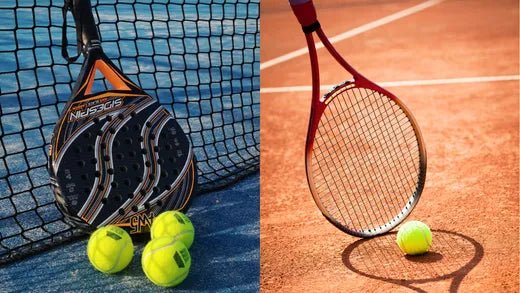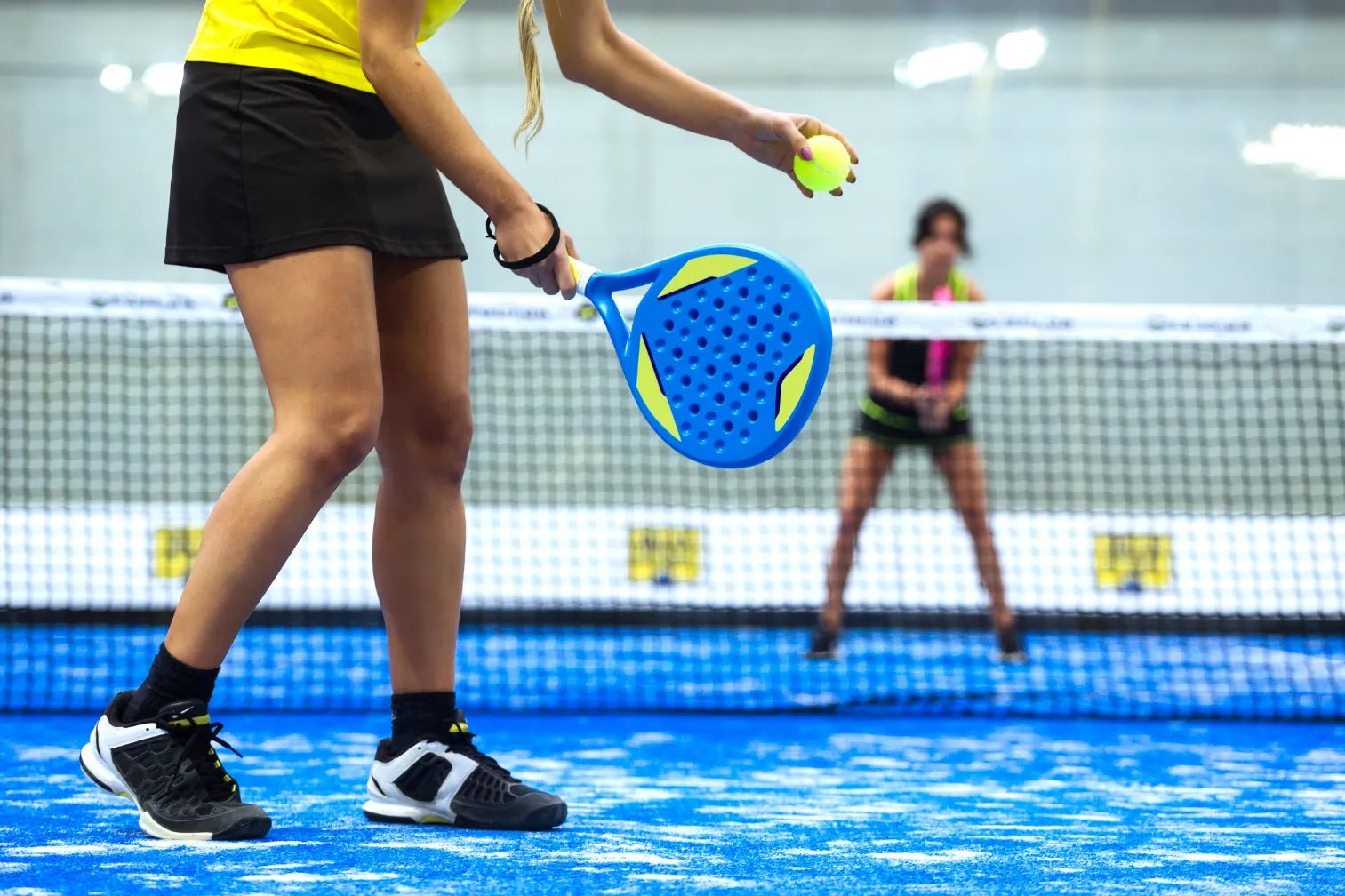Ever wondered what makes padel different from tennis? Sure, they both involve rackets, balls, and a net, but the similarities end there. From the court size to the gameplay, padel brings its own exciting twist to the world of racket sports—let’s explore how!
Aren’t Padel and Tennis the Same Thing?
Padel and tennis may look similar at a glance, but step into their worlds, and you’ll see they have distinct personalities. One feels like a classic you’ve always known, while the other is a modern twist full of surprises. If you’ve ever been curious about what makes them stand apart, you’re in for a treat.
For now, let’s just say padel has some unexpected quirks that shake up the typical racket sport experience. From the way the game flows to the feel of the equipment, it’s a sport that keeps you on your toes—literally and figuratively. But don’t worry, you don’t need to know all the details to start getting excited about what makes it so unique.
As you read on, we’ll unpack these differences one by one. Whether you’re a tennis enthusiast or new to both games, by the end of this blog, you’ll not only understand how they differ but also feel ready to pick up a racket and try one (or both!) for yourself. Ready to dive in? Let’s go!
What is Tennis?
Tennis is a beloved sport enjoyed by people of all ages and skill levels, whether for fun or in competitive matches. Players can compete solo in singles or team up in doubles, where strategy and teamwork shine. The game’s simplicity and fast-paced nature make it a favorite for those looking to stay active while having a great time.
The goal of tennis is straightforward—hit the ball over the net and into your opponent’s court to score points. Whether serving or returning, players aim to outmaneuver their opponents by forcing errors or gaining a tactical edge. With its mix of skill, strategy, and excitement, tennis continues to captivate players and fans worldwide.
Now, what about Padel?
Padel is a thrilling racket sport played on an enclosed court where the walls become part of the action. The game revolves around hitting the ball over the net into your opponent’s side, but here’s the catch—you can use the walls to keep the ball in play. This unique feature adds an exciting layer of strategy and creativity to every match.
Typically played in doubles, padel is as social as it is dynamic. The fast-paced rallies and clever use of space make it both engaging to play and watch. Whether you’re competing or just having fun, padel’s blend of teamwork and skill guarantees an unforgettable experience on the court.

What are the differences between Padel and Tennis?
When it comes to padel and tennis, the differences go beyond just the court and rules. In fact, there are at least 7 key aspects that set these two sports apart. From the rackets to the way the game is played, each one brings its own unique twist to the world of racket sports. Let’s dive into these differences and uncover what makes each game so special!
1. The Racket
One of the key differences between padel and tennis is the racket design. Padel rackets are smaller, solid, and perforated, with holes that reduce air resistance and help generate spin, unlike tennis rackets, which have strings. Additionally, padel rackets are shorter in length and feature a handle that fits just one hand, while tennis rackets are longer with a handle designed for two-handed grips.
3. The Ball
Padel and tennis balls may look similar, but they have differences. Padel balls are slightly smaller than tennis balls, with a diameter ranging from 6.35 cm to 6.77 cm, though they weigh the same. Additionally, padel balls have lower pressure, which makes them bounce less and move slower compared to tennis balls, which have higher pressure and a quicker, higher bounce.
3. The Court
Padel courts are smaller and have distinct boundaries compared to tennis courts. They are 20 meters long and 10 meters wide, with high walls around the sides and back, making the ball part of the game by bouncing off them. Moreover, padel courts feature a lower net, and their surfaces can vary from asphalt to artificial grass, while tennis courts are permanent and cannot be easily reassembled like padel courts, which can be transported and set up for competitions.
4. Strokes
Padel has developed its own unique strokes, like Vibora, Chiquita, and Bandeja, due to the slower pace and longer rallies of the game, which differ from tennis. For example, the forehand in padel uses a hammer grip and backspin, unlike the topspin forehand in tennis, and the serve in padel is underhand and hits below the waist, unlike the overhand serve in tennis. Additionally, padel incorporates shots like the back glass shot and Salida, where players use the walls and gates, adding a layer of strategy not found in tennis.

5. Game Format
Padel is typically played in doubles, with this format being the official one in tournaments, while tennis can also be played in doubles. Though both sports involve doubles play, their styles differ: in tennis, one player often stays at the net and the other at the baseline, while in padel, both players are positioned at the net after serving. This difference in positioning creates a distinct dynamic and strategy in each game.
6. Rules
The rules of padel closely resemble those of tennis, with both games sharing similar objectives and gameplay. However, a key difference is in the serve: in padel, the ball must be hit below the waist and after it bounces on the ground. This unique serving rule sets padel apart while keeping the overall structure of the game familiar.
7. Beginner-Friendliness
Padel is much more beginner-friendly than tennis, with its slower game pace, smaller court, and simpler strokes making it accessible to players of all levels and ages. The softer artificial grass courts also provide a more forgiving surface, reducing strain on players’ legs and backs. Unlike tennis, where complex strokes and techniques are required, padel’s easy-to-learn style allows players to progress faster and enjoy the game right from the start.
Adding to being a beginner-friendly type of sport, try the Golden Padel Racket, designed with one layer of glass fibre, one layer of carbon and one layer of 18K carbon fibre surface for durability and an 100% carbon fibre frame for lightweight strength. Its super soft EVA core offers excellent shock absorption, so you can play longer without discomfort. Overall, the Golden Padel Racket is a great choice for beginners, providing the perfect balance of ease and performance to help players enjoy the game right from the start.

Evidently, while padel and tennis share some similarities, the unique court size, rules, and equipment make each sport distinct, offering players different experiences and challenges.

Conclusion:
At the end of the day, while tennis holds its place as a beloved classic, padel offers a captivating blend of creativity, teamwork, and accessibility. Its unique elements, like the use of walls and a more forgiving pace, make it a perfect choice for both newcomers and seasoned players looking for a fresh challenge. But ultimately, the choice comes down to what excites you—whether it’s the speed and tradition of tennis or the dynamic, engaging nature of padel, both sports offer something special for everyone.
Glossary of terms:
- Padel - is a fast-paced racket sport played on an enclosed court, combining elements of tennis and squash, where players use solid rackets to hit a ball over the net and off the walls.
- Tennis - is a popular racket sport played on a rectangular court, where players aim to hit a ball over a net and into the opponent’s side, either individually (singles) or in teams (doubles), using a stringed racket to score points.
- Vibora - is a powerful padel shot similar to the Bandeja, but with more focus on generating speed and power, typically used to force the opponent into a defensive position.
- Chiquita - is a delicate padel shot that involves softly dropping the ball close to the net, aiming to catch the opponent off guard and force a weak return.
- Bandeja - is an overhead padel shot that is typically used to return a lob, emphasizing controlled spin and placement rather than power to keep the ball in play.
- Back Glass Shot - is a strategic move where the player hits the ball off the back glass wall, sending it over the net to surprise or outmaneuver the opponent.
- Salida - is a challenging and flashy shot where the player runs outside the court through a side gate to intercept a ball that has bounced over the wall.
References:
https://www.redbull.com/ph-en/what-is-padel-tennis-guide
https://www.bbc.co.uk/bitesize/guides/zcjdqty/revision/1
https://www.tennisleo.fi/padel-vs-tennis-eng/



Leave a comment
This site is protected by hCaptcha and the hCaptcha Privacy Policy and Terms of Service apply.